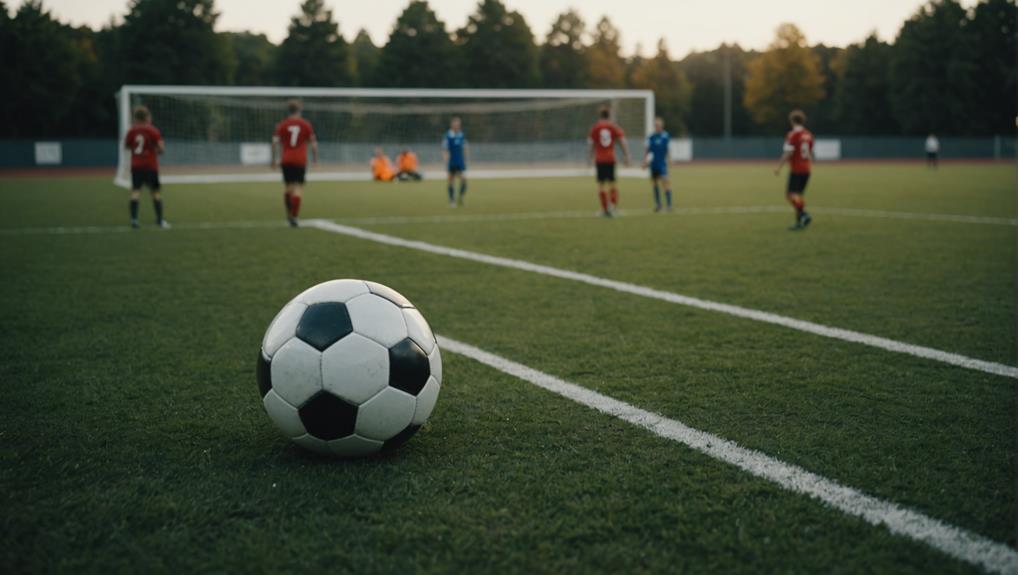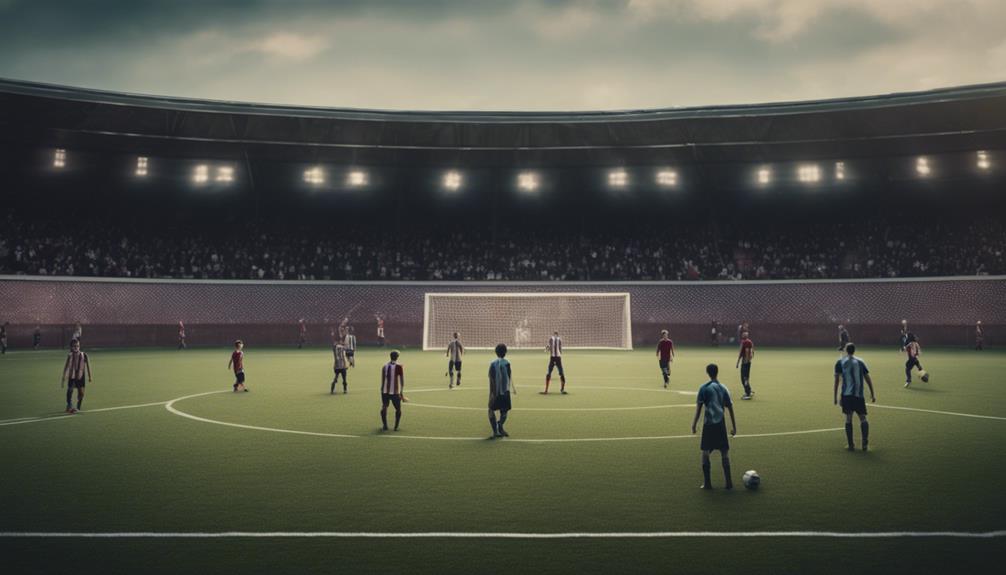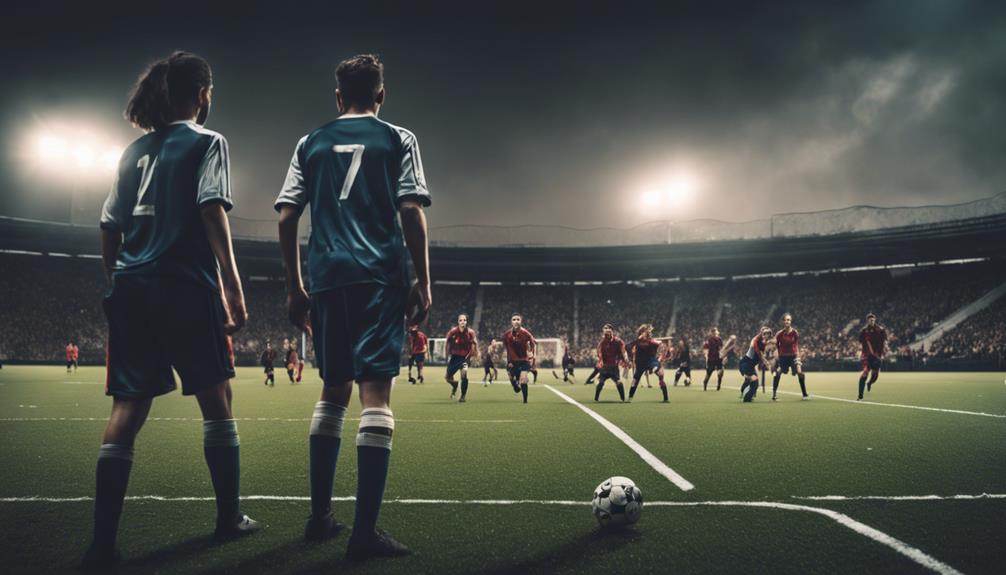
Understanding Soccer Positions in 7v7 Games
June 29, 2024Discover the essential defensive, midfielder, and attacking roles in 7v7 soccer games. Positions like center backs, full-backs, and defensive midfielders play critical roles in maintaining defensive solidity and moving smoothly into attack efficiently. Midfielders control possession, create scoring chances, and influence the game's tempo. Attacking responsibilities involve pressuring defenses, making strategic runs, and effective communication. Learn about formations like 2-3-1 and tactical approaches for midfield support. Explore how youth development benefits from formation experimentation and training techniques for honing positional awareness. Mastering these fundamentals will enhance your soccer game understanding and performance potential.
Overview of 7v7 Soccer Positions
In 7v7 soccer, understanding the roles and responsibilities of each position is essential for team success. The positions usually consist of goalkeepers, defenders, midfielders, and forwards. Defenders play an important role in the team's defense by focusing on stopping opponents and protecting the goal.
Midfielders, positioned in the central area of the field, are key players who control the game, shift between defense and attack, and create scoring opportunities for the team. Forwards, the attacking players, aim to score goals and apply pressure on the opposing defense.
Communication among players is crucial in 7v7 soccer, especially when shifting between offensive and defensive plays. Soccer formations help organize players on the field, ensuring that each position knows their role and responsibilities.
Defensive Roles and Responsibilities
As a defender in a 7v7 game, you play a pivotal role in thwarting the opposition's attacks and keeping your team secure. Your main tasks include:
- Guarding the goal
- Regaining possession
- Shutting down the opponent's scoring opportunities
Effective communication with your teammates and strategic marking are essential for a solid defensive performance.
Key Defensive Positions
Understanding the key defensive positions in 7v7 games is essential for players to fulfill their roles effectively and contribute to a solid defensive strategy. In this formation, center backs are tasked with marking and intercepting opponents, while full-backs provide vital support on the flanks and track opposing wingers.
The defensive midfielder plays a pivotal role as a shield in front of the defense, breaking up opposition attacks and initiating counter-attacks. Communication among these defensive players is paramount to maintain a cohesive defensive structure and thwart goal-scoring opportunities.
Tactical Marking Strategies
Defensive players in 7v7 games must execute precise marking strategies to neutralize opponents and secure defensive solidity. When thinking about tactical marking strategies, defenders play an important role in anticipating and countering the opponent's movements effectively.
Here are key points to take into account:
- Close Marking: Defenders should stick close to their assigned opponent to limit their space and time on the ball.
- Communication: Constant communication among defenders is essential to guarantee proper marking and tracking of opponent movements.
- Anticipate Plays: Understanding the opponent's tendencies allows defenders to anticipate plays, adjust their positioning, and intercept passes effectively.
- Proper Positioning: Maintaining the right defensive positioning is crucial to stay compact, cover passing lanes, and be prepared to challenge attackers when marking.
Communication and Teamwork
To excel in 7v7 games, effective communication and teamwork among defenders are paramount for maintaining defensive solidity and thwarting opponents' attacks. Defenders must communicate effectively to coordinate movements, cover spaces, and mark opponents efficiently. Clear communication allows defenders to anticipate threats, support each other during defensive changes, and work as a cohesive unit.
Understanding defensive roles and responsibilities is key to minimizing errors and maximizing defensive efficiency. By working together and supporting one another, defenders can form a strong defensive line that can withstand attacking pressure and secure the team's goal. Teamwork among defenders is essential for success in 7v7 games, as it allows the defense to function as a well-oiled machine, frustrating opponents and preventing scoring opportunities.
Midfielder Duties in 7v7 Games

Midfielders in 7v7 games serve as the linchpin for their team's performance, bridging the gap between defense and attack with their strategic play. In these smaller-sided matches, midfielders play a pivotal role in controlling possession, shifting the ball from defense to attack smoothly, initiating key counterattacks, and supporting their teammates in all phases of play.
Here are some key duties of midfielders in 7v7 games:
- Control Possession: Midfielders are tasked with maintaining possession of the ball, dictating the flow of the game, and ensuring their team has control over the match tempo.
- Shifting Play: They play a vital role in maneuvering the ball from defense to attack smoothly, initiating quick counterattacks, and supporting their teammates in all phases of play.
- Defensive Awareness: Midfielders need to exhibit strong defensive awareness, tracking back to support the defense, intercepting passes, and breaking down the opponent's plays.
- Creating Scoring Opportunities: Besides providing defensive support, midfielders are key in creating scoring chances, delivering precise passes, and positioning themselves effectively to capitalize on attacking opportunities.
In 7v7 games, midfielders truly are the engine that drives their team forward, contributing both defensively and offensively to secure victory.
Attacking Responsibilities in 7v7
As an attacker in 7v7 games, your main responsibility is pressuring the defense and creating scoring opportunities for your team. Good positioning is essential to stretch the field and provide passing options for your teammates.
You need to make runs behind the defense, receive passes in tight spaces, and finish chances to be effective in the attack.
Forward's Role in Attack
In a 7v7 soccer game, the forward plays a pivotal role in attacking by pressuring the opposition's defense and creating scoring opportunities. The forward needs to stay alert for through balls and chances to make runs behind the defense.
In addition, they must have good positioning inside the box to capitalize on crosses and rebounds. Communication with midfielders is essential for coordinated attacks and exploiting gaps in the defense.
Moreover, tracking back to support defensively and help regain possession is also part of the forward's responsibilities in a 7v7 game.
- Stay alert for through balls and opportunities to make runs behind the defense.
- Maintain good positioning inside the box to capitalize on crosses and rebounds.
- Communicate effectively with midfielders for coordinated attacks.
- Track back to support defensively and help regain possession.
Midfielders' Creative Contributions
With their creative flair and strategic play, midfielders in 7v7 games greatly influence the team's attacking prowess. These players have important attacking responsibilities, such as creating goal-scoring opportunities and dictating the tempo of the game.
Midfielders act as playmakers, using their vision and passing accuracy to orchestrate attacks and link the defense to the forwards effectively. In this role, they play a significant part in maintaining possession and supporting the team in both defensive and offensive shifts. Their ability to make quick decisions and provide creative contributions can change the course of the game.
Effective midfielders in 7v7 soccer are adept at outmaneuvering opposition defenses through clever passing and movement. As a result, midfielders aren't only essential for ball circulation but also serve as the creative heartbeat of the team, driving attacking plays and setting the rhythm of the game.
Strategic Formations for 7v7 Matches

Consider adopting various strategic formations like 2-3-1, 3-2-1, and 2-2-2 to optimize your team's performance in 7v7 soccer matches. These formations provide a framework for your team's defensive structure, midfield support, and attacking options.
Here are some key points to keep in mind when choosing a strategic formation:
- Defensive Formation: Choose a formation like 3-2-1 for solid defensive stability, especially when facing stronger opponents.
- Midfield Support: Formations with two midfielders, like 2-3-1, offer important support in shifting from defense to attack.
- Attacking Options: Consider formations like 2-2-2 for flexibility in creating attacking opportunities through disciplined player runs.
- Youth Soccer: In youth soccer, experimenting with different formations can help players understand tactical nuances while developing their skills.
Training Tips for Positional Awareness
To enhance your team's performance on the field, prioritize teaching players to grasp their specific roles and responsibilities within their positions through targeted training on positional awareness. For example, central defensive midfielders should focus on shielding the defense and distributing the ball efficiently, while attacking midfielders need to be creative in linking up play and supporting the forwards.
Incorporate positional drills that emphasize movement, spacing, and decision-making in relation to teammates. Use game-like scenarios during training to help players recognize and react to different positional situations.
Encourage effective communication among players to maintain proper positioning and support throughout the game. Providing feedback and guidance on improving positional awareness and decision-making will help players understand their roles better and make more informed choices on the field.
Conclusion
Now that you understand the ins and outs of soccer positions in 7v7 games, you're ready to hit the field with confidence. Remember, like pieces on a chessboard, each player has an essential role to play in the game's intricate dance.
Stay focused, communicate with your teammates, and always be ready to make a move. With practice and dedication, you'll be a key player in no time.
Keep kicking, keep scoring, and most importantly, keep having fun out there!


